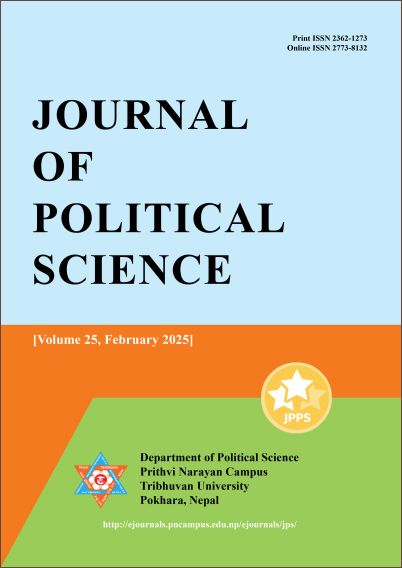An Analysis of Government Expenditure and Revenue in Nepal: Trends, Challenges and Policy Implications
DOI:
https://doi.org/10.3126/jps.v25i1.75776Keywords:
Capital expenditure, government expenditure, government revenue, Nepal, recurrent expenditureAbstract
This study provides a comprehensive examination of the trends and patterns in government expenditure and revenue in Nepal, spanning from fiscal year 1975/76 to 2024/25. Using time series data analysis and visual representations, the research identifies key phases of growth, contraction, and structural shifts in Nepal's fiscal landscape. Government expenditure has shown a sustained upward trajectory, with distinct periods of sharp increases and moderation. The period 1990/91–1994/95 witnessed significant growth in expenditure, averaging 17.33% annually, driven by the democratic transition and the prioritization of social and infrastructure development. Similarly, the highest growth rate of 60.95% was observed in 2009/10, fueled by post-conflict reconstruction and development efforts. Conversely, fiscal constraints resulted in minimal growth, as low as 0.3% in 2001/02, during political instability. The research categorizes expenditure into recurrent and capital components, revealing a structural shift in fiscal priorities. Recurrent expenditure, which primarily encompasses administrative and public service obligations, began to surpass capital expenditure post-1995/96. This shift highlights the growing demand for government services and the challenges of balancing short-term operational costs with long-term investment needs. On the revenue side, the study reveals a robust upward trend, with significant improvements in growth rates during periods of political stability and economic reforms. The peak revenue growth rate of 24.14% was recorded during 2005/06–2009/10, reflecting enhanced tax collection mechanisms and fiscal policies. However, the analysis also notes a recent moderation in revenue growth, attributed to structural challenges in the economy and external shocks. In conclusion, the study underscores the dynamic interplay between government expenditure and revenue in shaping Nepal’s fiscal trajectory. It calls for strategic fiscal management to address emerging challenges such as rising recurrent expenses and slower revenue growth. The findings provide critical insights for policymakers aiming to enhance resource allocation, promote economic stability, and ensure sustainable development in Nepal's evolving fiscal landscape.
Downloads
Downloads
Published
How to Cite
Issue
Section
License

This work is licensed under a Creative Commons Attribution-ShareAlike 4.0 International License.




